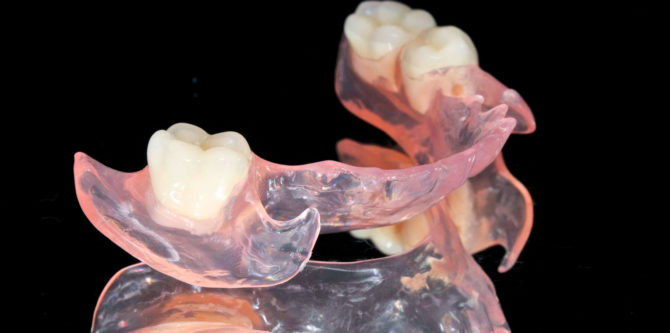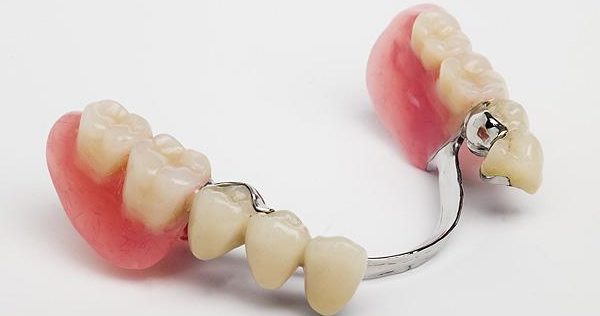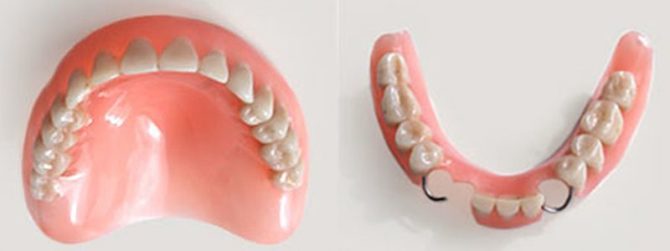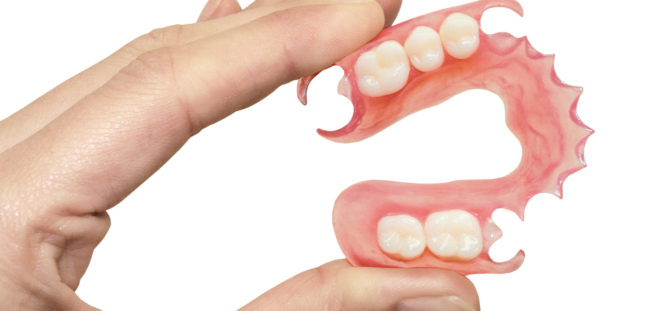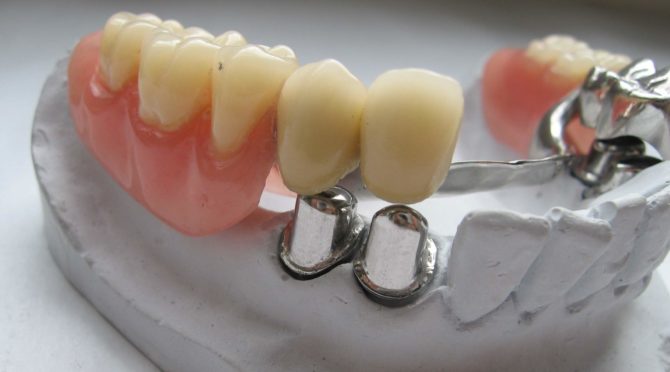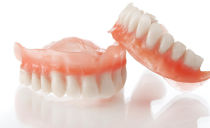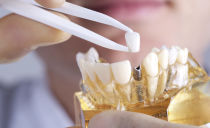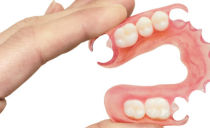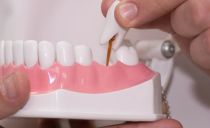New generation dentures without palate with complete and partial absence of teeth
Dentures of a new generation, which do not cover the sky, do not cause gagging, impaired diction and other unpleasant sensations, do not fly off and practically do not require addiction.
Content
Main characteristics
The task of the new generation prostheses is to preserve the functionality of the dentition without causing unpleasant sensations in the patient. A pleasant addition is the most natural look of artificial teeth, recreating the naturalness and beauty of a smile.
The prosthesis allows you to evenly distribute the chewing load, which eliminates the overload of supporting teeth, damage to soft and hard tissues of the oral cavity. Products are made of wear-resistant, strong and durable materials.
The advanced design does not involve support on the gum and takes up a minimum of space without covering the skylike old-fashioned plastic prostheses. Due to the soft and light materials, thoughtful design, the addiction to products is minimal.
Dentures of a new generation without palate allow you to save the taste perception of food, since the sky, where a certain number of taste buds are concentrated, remains open. The salivation process is not disturbed either: neither excessive salivation nor excessive dryness in the oral cavity is observed. Dentures do not provoke vomiting, impaired taste and diction, and do not create a foreign body sensation in the mouth.
Varieties of prostheses
There are a large number of types of prosthetic products without palatine arches. To choose the optimal design among them, you need to know the main characteristics and features of the products.
Clasp
Clasp constructions are not in the patient’s mouth 24 hours a day, they can be removed for a while. These removable dentures without a palate can be used both with a complete absence of teeth and with a partial one. Clasps are installed on live teeth and on artificial crowns. The number of missing teeth only affects the choice of attachment system, without affecting the quality, comfort and functional efficiency.
You can see how the clasp looks in the photo:
The principles of fastening clasp systems:
- Fastening with clasps (metal hooks), which are attached to not prepared abutment teeth.
- The telescopic principle of fastening when the design is mounted on special crowns.
- Micro locks (attachments) inserted into the crown, fixed on the abutment. In addition to functionality, attachment attachments are characterized by a pronounced aesthetic advantage due to the hidden attachment, which is invisible to others.
Advantages and disadvantages
The advantages of clasp systems include lightness, compactness, long service life of the structure, natural appearance, sparing effect on adjacent teeth, protection of supporting teeth.
The disadvantages of clasp models include the impossibility of constant wear (must be removed for a while), the need for addiction. If the clasp prosthesis is attached with clasps, it is visible during a conversation.
Acrylic
Dentures made of acrylic plastic are the most inexpensive and simplest in design.Among their other advantages, we can distinguish simplicity in operation, simple repair for various damages, an acceptable aesthetic appearance.
The disadvantages of prostheses include:
- low elasticity, which leads to rubbing of the gum tissue and possible gum atrophy;
- soreness and impaired diction while wearing;
- inability to withstand severe loads (chewing solid food);
- low ductility of the material can lead to fracture of the product;
- allergic reactions are possible.
Often, the low plasticity of acrylic leads to a mismatch of the product to the prosthetic bed of soft tissues, which is fraught with unreliable fixation of the prosthesis in the oral cavity.
Nylon
Soft dentures without a palate are created from nylon and are attached to the teeth by “suction”. Nylon plastic is widely used in modern prosthetics due to its unique properties:
- The material from which the product is made has high hypoallergenic properties, so the risk of developing an allergic reaction is minimal.
- High strength and structural stability to mechanical stress and negative external factors.
- The relative elasticity of nylon makes it immune to damage.
- The product practically does not cause discomfort, this is due to the minimum term of getting used to the design.
- Aesthetic appeal. Nylon models are indistinguishable from natural teeth, they look natural and harmonious due to invisible fastening.
What a nylon product looks like, you can see in the photo:
Despite the long service life (up to 7 years), nylon dentures stain over time. Therefore, when using them, it is not recommended to abuse “coloring” foods and drinks (coffee, strong tea, sour foods).
Uneven load when chewing food can lead to atrophy of bone or soft tissue (in the case of complete absence of teeth). Restoring the product after a breakdown is almost impossible, in which case a new model is manufactured.
Combined dentures "Acre-Free"
Acry-Free prostheses combined the positive characteristics of nylon and acrylic plastic, which makes a denture without a palate light, dense and flexible. Other benefits:
- There is a high degree of fit of the prosthesis to the gums without the use of additional creams and gels.
- A short list of contraindications makes it possible to use Acre-Free people with periodontal disease.
- Perhaps the use of complete loss of teeth. The special properties of Acry-Free materials (elasticity, strength) allow you to maintain the normal state of soft and hard tissues.
- This type of prosthesis has hypoallergenic properties, which eliminates the occurrence of allergic reactions.
- The prosthesis is easy to clean, does not cause discomfort, impaired taste and diction, is resistant to negative external influences (does not absorb moisture, odors).
The disadvantages of this type of prostheses include limited plasticity, the possibility of bone atrophy (to avoid it is recommended to leave Acre-Fri overnight), and not the longest operational period (5-7 years).
Quadrotti
With partial loss of dental units and retained abutment teeth, the installation of removable Kvadrotti prostheses is optimal. These prostheses are sandwich systems that are attached by attachments (microscopic locks).
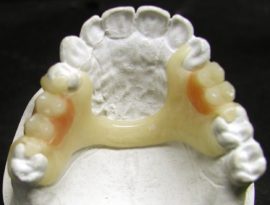 Kvadrotti prostheses consist of several parts:
Kvadrotti prostheses consist of several parts:
- artificial teeth;
- imitation of natural gums;
- elastic fixing hooks.
Attachments tightly fix the structure due to a special latch without damaging the tooth enamel due to its plastic properties. The system does not require special pastes for more stable fixation.
The design is a conditionally removable prosthesis, which is removed in cases of special need (control examination of the dentist). The rest of the time, the Quadrotti prosthesis is worn constantly.
The comfort of wearing the “Quadrotti” is due to the plastic materials of which the product is made, and a narrow palatine overlap. The sky remains as open as possible, due to which taste perception is preserved, there are no unpleasant sensations and reactions.
Telescopic dentures
The most reliable modern removable dentures without a palate are constructions with telescopic fastening. This type of construct consists of two parts - fixed and removable. A fixed base, which is a metal crown, is put on a tooth support. Subsequently, the metal plate is cemented. The removable part, which is the prosthesis where the crowns are inserted, is put on special supports, which allows it to be securely fixed and, if necessary, easy to remove.
Telescopic systems allow you to evenly distribute the load when chewing, comfortable, light and invisible when worn.
The choice of a removable denture without the palate in the complete absence of teeth
Thanks to the latest technology, it became possible to produce comfortable and functional prostheses without a palate with a complete loss of dental units. Thanks to the advanced modern prosthetics, each person suffering from a complete lack of teeth can install an upper denture without a palate and / or a lower one without a hyoid arch. Such designs allow you to fully recreate the necessary functions of the dentition, to return a smile of naturalness and attractiveness.
The main aspects of complete prosthetics:
- The most important condition is a strong fixation of the prosthesis. For people who have lost all their teeth on the upper and / or lower jaw, a reliable solution is to install a removable or conditionally removable prosthesis without a palate and mounted on implants.
- The main methods of implantation: classical (implants are inserted into the spongy bone of the alveolar processes), basal (implants are inserted into the dense bone) and implantation of mini-implants.
- As prostheses fixed on implants, we use models made of the same materials as the products used for partial loss of teeth (Acre-Free, nylon). With full adentia clasp dentures cannot be used.
Installing a prosthesis without a palate
Before installing the prosthesis, the dentist conducts a number of preparatory measures aimed at processing the remaining teeth and taking measurements for the manufacture of the structure. Preparation and installation steps include:
- Turning of all remaining teeth. If they are enough to fix the structure, then they will act as a support. If the patient does not have all the teeth, you will have to implant implants in the jaw bone.
- When all the teeth are honed, the dentist covers them with artificial metal crowns. Such products are called the original elements of telescopic crowns.
- Measurements are taken from the upper and lower jaw, without which it is impossible to make a denture without the palate. Then, dental technicians make a prosthesis without a palatine arch for the upper jaw or without a hyoid element for the lower.
- Secondary elements of telescopic crowns that will participate in the chewing process are attached to the finished prosthesis. They are fixed using soldering or an adhesive solution.
- The last stage of prosthetics is the installation of the prosthesis on the teeth by combining the primary and secondary elements of telescopic crowns.
New-generation prostheses are products that can make a smile beautiful, and a comfortable meal.

